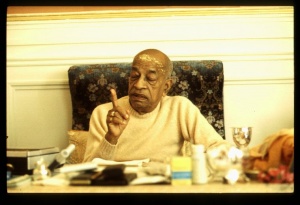SB 1.17.1: Difference between revisions
No edit summary |
(Vanibot #0054 edit - transform synonyms into clickable links, which search similar occurrences) |
||
| Line 25: | Line 25: | ||
<div class="synonyms"> | <div class="synonyms"> | ||
''sūtaḥ uvāca'' | ''[//vanipedia.org/wiki/Special:VaniSearch?s=sūtaḥ&tab=syno_o&ds=1 sūtaḥ] [//vanipedia.org/wiki/Special:VaniSearch?s=uvāca&tab=syno_o&ds=1 uvāca]'' — Śrī Sūta Gosvāmī said; ''[//vanipedia.org/wiki/Special:VaniSearch?s=tatra&tab=syno_o&ds=1 tatra]'' — thereupon; ''[//vanipedia.org/wiki/Special:VaniSearch?s=go&tab=syno_o&ds=1 go]-[//vanipedia.org/wiki/Special:VaniSearch?s=mithunam&tab=syno_o&ds=1 mithunam]'' — a cow and a bull; ''[//vanipedia.org/wiki/Special:VaniSearch?s=rājā&tab=syno_o&ds=1 rājā]'' — the King; ''[//vanipedia.org/wiki/Special:VaniSearch?s=hanyamānam&tab=syno_o&ds=1 hanyamānam]'' — being beaten; ''[//vanipedia.org/wiki/Special:VaniSearch?s=anātha&tab=syno_o&ds=1 anātha]-[//vanipedia.org/wiki/Special:VaniSearch?s=vat&tab=syno_o&ds=1 vat]'' — appearing to be bereft of their owner; ''[//vanipedia.org/wiki/Special:VaniSearch?s=daṇḍa&tab=syno_o&ds=1 daṇḍa]-[//vanipedia.org/wiki/Special:VaniSearch?s=hastam&tab=syno_o&ds=1 hastam]'' — with a club in hand; ''[//vanipedia.org/wiki/Special:VaniSearch?s=ca&tab=syno_o&ds=1 ca]'' — also; ''[//vanipedia.org/wiki/Special:VaniSearch?s=vṛṣalam&tab=syno_o&ds=1 vṛṣalam]'' — lower-caste śūdra; ''[//vanipedia.org/wiki/Special:VaniSearch?s=dadṛśe&tab=syno_o&ds=1 dadṛśe]'' — observed; ''[//vanipedia.org/wiki/Special:VaniSearch?s=nṛpa&tab=syno_o&ds=1 nṛpa]'' — a king; ''[//vanipedia.org/wiki/Special:VaniSearch?s=lāñchanam&tab=syno_o&ds=1 lāñchanam]'' — dressed like. | ||
</div> | </div> | ||
Latest revision as of 18:02, 17 February 2024

A.C. Bhaktivedanta Swami Prabhupada
TEXT 1
- sūta uvāca
- tatra go-mithunaṁ rājā
- hanyamānam anāthavat
- daṇḍa-hastaṁ ca vṛṣalaṁ
- dadṛśe nṛpa-lāñchanam
SYNONYMS
sūtaḥ uvāca — Śrī Sūta Gosvāmī said; tatra — thereupon; go-mithunam — a cow and a bull; rājā — the King; hanyamānam — being beaten; anātha-vat — appearing to be bereft of their owner; daṇḍa-hastam — with a club in hand; ca — also; vṛṣalam — lower-caste śūdra; dadṛśe — observed; nṛpa — a king; lāñchanam — dressed like.
TRANSLATION
Sūta Gosvāmī said: After reaching that place, Mahārāja Parīkṣit observed that a lower-caste śūdra, dressed like a king, was beating a cow and a bull with a club, as if they had no owner.
PURPORT
The principal sign of the age of Kali is that lower-caste śūdras, i.e., men without brahminical culture and spiritual initiation, will be dressed like administrators or kings, and the principal business of such non-kṣatriya rulers will be to kill the innocent animals, especially the cows and the bulls, who shall be unprotected by their masters, the bona fide vaiśyas, the mercantile community. In the Bhagavad-gītā (BG 18.44), it is said that the vaiśyas are meant to deal in agriculture, cow protection and trade. In the age of Kali, the degraded vaiśyas, the mercantile men, are engaged in supplying cows to slaughterhouses. The kṣatriyas are meant to protect the citizens of the state, whereas the vaiśyas are meant to protect the cows and bulls and utilize them to produce grains and milk. The cow is meant to deliver milk, and the bull is meant to produce grains. But in the age of Kali, the śūdra class of men are in the posts of administrators, and the cows and bulls, or the mothers and the fathers, unprotected by the vaiśyas, are subjected to the slaughterhouses organized by the śūdra administrators.